|
Historical Paintings of Maine
Exhibited August 10 to Sep 10 2011
"Few if any external influences have made themselves more potently felt in American art than the geographic one exhibited by the coast of Maine. There is something characteristically American typified by these rugged, rocky shores, which has been the inspiration of some of our greatest and most truly national paintings."
- Art Historian, Ralph Carey
Paul Bernard King, N.A. (1867-1947)
Monhegan Island Harbor
25 x 30 Oil (relined),Antique carved frame 31 x 36
Price available upon request
Versatility, artistic maturity and mastery of technique and medium are hallmarks of Paul King's art. His diverse works of portraits, landscapes, rural scenes and illustrations establish his reputation in the first quarter of the century.
From 1906, when his oil painting "Hauling in the Anchor Line" (date and location unknown) captured the Salmagundi Club's top two prizes, King regularly received recognition. His merit was freely acknowledged by his artist peers, as well as by the critics and the public.
King was born in 1867 to a Buffalo, New York goldsmith. Apprenticed there to a lithography firm, he became an accomplished printer. King later studied at the Art Students League of Buffalo and, from 1901 to 1904, at the New York Art Students League with Henry S. Mowbray. While a student, he was an illustrator for "Life" and "Harper's" magazines. From 1905 to 1906, King studied in Holland with Willy Sluiter, Evert Pieters and Bernard Bloomers.
He was a board member of the Philadelphia School of Design for Women, serving as vice president and acting president, from 1908 to 1921. In 1921, he moved from his long-time home in Germantown section of Philadelphia to Stony Brook, Long Island, where he died in 1947.
Memberships: Allied Artists,America Federation of Arts, Artists Aid Society, Artists Fund Society, International Society of Arts and Letters, Pennsylvania Academy of Fine Arts, Philadelphia Art Club, Salmagundi Club
Public Collections:Albright-Knox Gallery, Buffalo; Butler Art Institute, Youngstown, Ohio; National Gallery of Art, Washington, D.C.; Reading Museum, Pennsylvania; Los Angeles Museum; Houston Art Museum; New Pantheon, Nashville, Tennessee. (From "American Art Analog").
Biography from Roughton Galleries,Inc
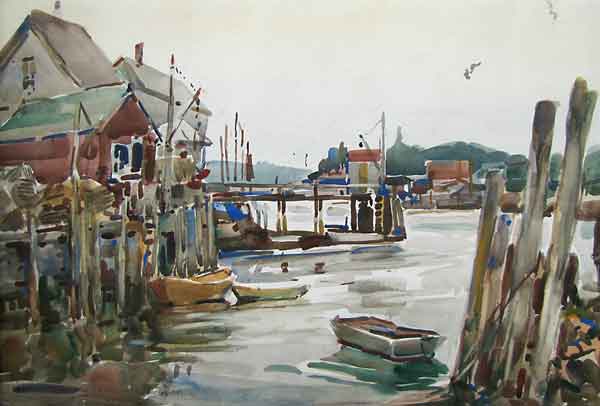
William Lester Stevens (1888-1969)
Harbor at Vinalhaven, Maine
Signed "W. LESTER STEVENS N.A." l.r.
Watercolor 15 x 22 in.
$2400
Born in Rockport, Massachusetts, Stevens spent four years at Boston's Museum of Fine Arts School, where he studied under Edmund Tarbell, among others. Primarily an oil painter, he also used watercolor and acrylics. He is best known for his post-impressionistic landscapes. Throughout the course of his long career, Stevens taught, first in Rockport, then at Boston University (1925-1926) and Princeton (1927-1929), and during the Depression at Grand Manan.
He was a National Academician and a member of the American Watercolor Society; a founding member of the Rockport Art Association; Springfield, MA Art League; Guild of Boston Artists; Gallery on Moors; New Haven Paint and Clay Club, CT; Gloucester Society of Art; North Shore Art Association; Boston Watercolor Club and the New York Watercolor Club. He won art awards at the Corcoran Gallery, Washington, DC; American Watercolor Society; New Haven Paint and Clay Club; Springfield Art League; Salons of America; Washington Watercolor Club; North Shore AA; Rockport AA and more. He painted USPO murals in Dedham and Rockport, MA, the Boston City Hall, the Louisville, KY Art Museum and several schools in Boston. References: Movalli, Charles, American Artist (April 1986); Who’s Who in American Art (1947); Who Was Who in American Art (vol. 3, p. 3171-72).
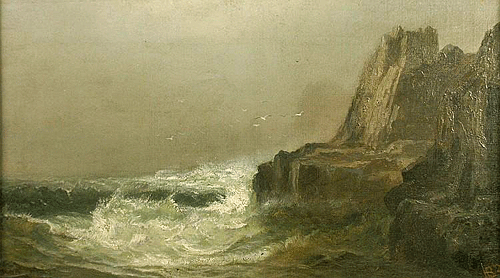
Harrison Bird Brown (1831-1915)
View of Grand Manan
Oil on Canvas 10x18
$5500 Framed
Harrison Bird Brown was born in 1831 in Portland, Maine, and is best known for his White Mountain landscapes and marine paintings of Maine's Casco Bay. By 1860, Brown was being praised as a leading American marine painter. Brown was one of the early artists to paint the coastline of Maine's Monhegan Island, where he depicted the headlands as awesome, mystical forces. Humanity versus nature, and the human relationship to nature, themes prevalent in mid and late-19th century literature and philosophy, figured frequently in his seascapes.
The coast of Maine was a favorite painting venue of Brown's for over thirty years. He depicted the wholesome outdoor environment of the state, with special fondness for the Casco Bay area and Grand Manan, an island off the New Brunswick, Canada coast. Brown also produced two widely distributed illustrations of Crawford Notch for the Maine Central Railroad in 1890.
Harrison Bird Brown exhibited at the National Academy of Design in New York from 1858 to 1860, and at the Boston Athenaeum and Philadelphia Centennial Exposition in 1876. By 1892 he had become the best known native Maine painter of his time, and gained fame for himself and the state with a large canvas in the Maine pavilion of the 1893 World's Colombian Exposition in Chicago. In 1892 he was elected president of the Portland Society of Art.
|
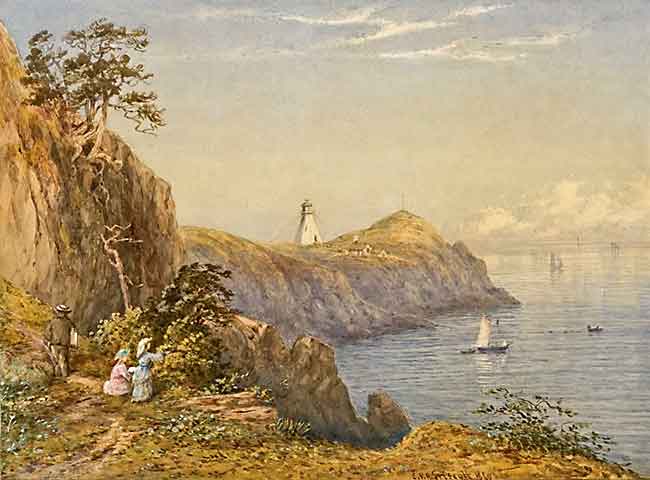
Sparrowhead Light House, Grand Manan
Samuel Peter Rolt Triscott
17.50" x 23.38"
Created: 1890
Framed under glass with mat 28x34
$9000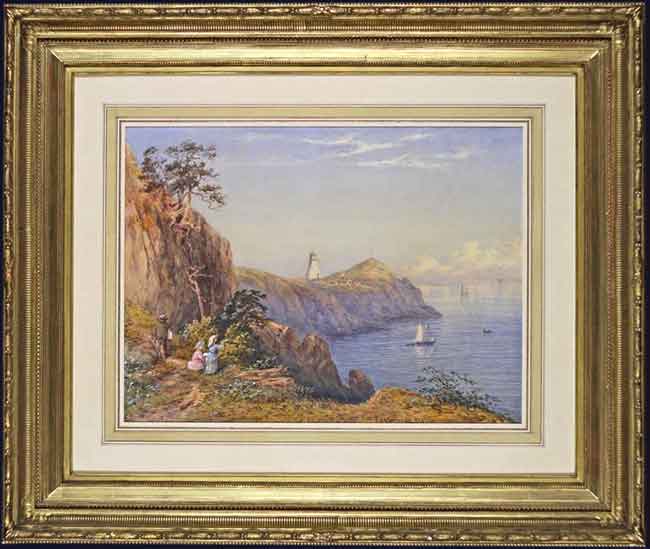
Samuel Peter Rolt Triscott was born January 4, 1846 in Gosport, England. He was one of five children and had a genteel middle class upbringing. Triscott studied civil engineering. His artistic training in painting was at the Royal Institute of Painters in Water Colors in London under Philip Mitchell.
In 1871 Triscott moved to America and settled in Worcester, Massachusetts where he was a partner in a civil engineering firm. In 1874 he began selling paintings from his office in Worcester. In 1881 Triscott had a one man show at the Boston Art Club. His style of painting with fluent washes of transparent color, though a change from the accepted norm, was well received. Triscott worked as a painting teacher during this time and it is believed his students included Winslow Homer, Sears Gallagher, William J. Bixbee, Woodbridge Gee, Melbourne H. Hardwick, Charles Copeland, William Ladd Taylor, and Robert Henri.
Triscott became quite active in the art world and showed regularly at the Boston Art Club, the American Watercolor Society in New York, The Pennsylvania Academy of Fine Arts and the Gallery of J. Eastman Chase. In 1885, he was one of the founding members of the Boston Society of Water Color Painters.
Triscott began visiting Monhegan Island off the coast of Maine in the early 1890's. The artist purchased a large lot of land which he sold off for cottages in his later years. Every year Triscott increasingly spent more time on the island eventually staying there year round. On April 28, 1894 Triscott was naturalized in Boston. He returned to Monhegan Island and continued to show his work and receive exceptional reviews. S.P. R. Triscott died on April 15, 1925 on Monhegan Island.
Source:
"American Art Review", December 2002
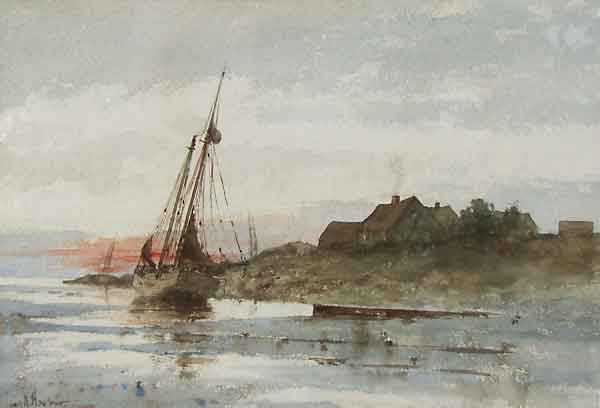
Louis Kinney Harlow (1850-1913)
Low Tide, circa 1890
Watercolor, signed l/l
13" x 19", 20" x 25.5" framed
$1800
Louis Kinney Harlow, painter and etcher, was known for his New England landscapes, fishermen, farms, boats, and coastal scenes. He was born on March 28, 1850 in Wareham, MA. After attending school at Phillips Academy in Andover, MA, Harlow went into business and married Julia Coombs. They started their family and eventually had three children.
Harlow started his career as a professional artist in 1880 and exhibited with the Boston Art Club in 1883, 1885, 1887, and 1894. During the early 1880s he was teaching in Detroit but moved back to Boston in the mid-1880s. Sometime before the 1890s, he went to England, Paris, and Holland to study the work of the masters. Fielding's Dictionary of American Painters, Sculptors & Engravers lists him as a watercolor artist and etcher, but his auction records also show a list of oils, pastels, gouache, and mixed media.
Harlow's work is represented in the collections of the Strong Museum in Rochester, NY and the Whyte Museum of the Canadian Rockies in Banff, Alberta. References: Who Was Who in American Art, 1999, page 1461; Davenport's Art Reference, 2006/2007Edition, page 956; Boston Art Club 1855-1950, Vose Galleries Boston, MA, page 74; Boston Art Club Exhibition Record 1873-1909, page 203; Smithsonian Institution Research Information System.
Biography adapted from AskART: Peter Kostoulakos, AOA, NEAA: Fine Art Consultant, www.pkart.com
|
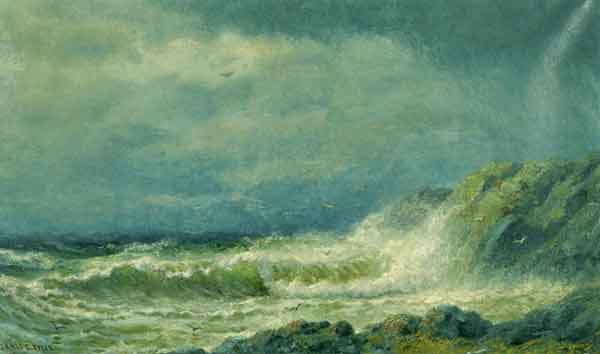
JAMES GALE TYLER (1855-1931)
Rocky coastal scene. Signed ll, James G. Tyler".
Oil on canvas, 18" x 30". Framed. 23 x 35
$3200
One of America’s foremost marine artists, James Gale Tyler was born in Oswego, New York in 1855. His interest in marine subjects began early, as by age 15 he was showing fascination with the ocean and seagoing vessels. He moved to New York City where, studying with A. Cary Smith, he took his only formal art lessons. Tyler's signature painting became known for the emphasis on mood and impression rather than for detailed realism.
He got much of his subject matter from his yearly travels between 1900 and 1930 to Newport, Rhode Island to paint scenes from the America's Cup Race. Many important illustration commissions as well as painting requests came his way during his lifetime. Among his illustration clients were publishers of Harper's, Century and Literary Digest. Tyler worked in New York and Providence, Rhode, Island in the mid 1880s-1890s, but it was Connecticut where he primarily worked and lived from 1870 until his death in 1931 at Pelham, New York. In addition to other marine scenes, Tyler painted every America’s cup race from 1900 to 1930. About his career, it was written that "No aspect of maritime life escaped Tyler's attention. In addition to painting all types of boats-from old sloops to clipper ships-he painted a variety of seamen, coastal scenes and seascapes."
He was a member of the Brooklyn Art Club, Artists Fund Society, Greenwich Society of Artists and the Salmagundi Club. He exhibited extensively at the National Academy, the Providence Art Club, the Boston Art Club and the Brooklyn Art Association and the PAFA. His work is in permanent collections at the Corcoran Gallery, Washington, DC; Tokyo Museum; Wadsworth Athenaeum, Hartford, CT; Omaha Museum of Art, NB; Mariner’s Museum, N.Y. Historical Society and elsewhere. James Tyler was primarily a resident of Greenwich, Connecticut, but the year he died, 1931, he moved to Pelham, New York. Tyler’s paintings are effused with subtle effects of light, vibrant color, and careful detail. It is for these reasons that Tyler’s paintings were extremely popular during his lifetime and continue to be popular today.
Source:
American Art Analog, Volume II, compiled by Michael David Zellman in association with American Art Analog, 1986, p. 513
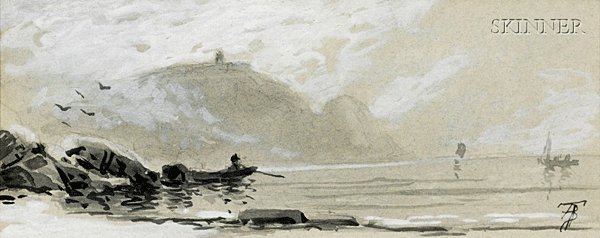
Alfred Thompson Bricher (1837-1908)
Figure in a Boat Near Shore
Monogrammed l.r., labels from Barridoff Galleries, Portland,
Watercolor and gouache en grisaille on paper,
sight size 2 3/8 x 6 in. framed
$2800
An Associate of the National Academy, Alfred Thompson Bricher was known especially for his serene, luminist seascapes, reminscent of works by Fitz Hugh Lane and Martin Johnson Heade. Born April 10,1837, Portsmouth, NH, Bricher grew up in Newburyport, MA. Largely self-taught, Bricher studied art at Lowell Institute, Boston in the 1850's. In the 1860s he followed his contemporaries to the White Mountains, and was active in Boston and Newburyport, MA until 1868 when he moved to New York. He executed his best work during the 1870s-80s when he spent many summers painting on the coasts of Massachusetts, Maine (Monhegan Island), and Rhode Island (1871-76), as well on Long Island, especially at Southampton.
Bricher was a significant second-generation Hudson River School landscapist and marine painter who is considered to be the last of the relevant American luminists. He is best known for his marine paintings depicting New England shorelines, in which crashing waves show the dynamic forces of nature.With ease and finesse he captured the natural ambiance around the ocean and its coasts and the artist’s reverence for the presence of what is before him is apparent.
Today A.T. Bricher is considered one of the finest marine painters of his era, and his work is in great demand because each of his canvases and watercolors show resplendently and with confident brushwork how nature looked during the late 19th and early 20th centuries.

Sunset, Monhegan
Jay Hall Connaway (1893-1970)
Signed "Connaway" l.r., titled reverse.
Oil on board, 24 x 29 in.
$6000
Born in Liberty, Indiana, Jay Hall Connaway was fascinated by coastal life and marine scenery, an attraction that had profound effects on his life and artwork. After periodically studying at the Art Institute of Indianapolis and at the Art Students League with William Merritt Chase, Connaway traveled throughout the United States.ndertake further study in Paris at the Academie Julian and at the Ecole des Beaux-Arts. Encouraged by Robert Macbeth (Macbeth Gal., NYC) and artists Paul Dougherty, Emil Carlsen, and Frederick Waugh, he spent 1922-25 painting at Head Harbor, ME. From 1929-31 he was painting in Brittany and Paris, sponsored by Macbeth and Milch. Returning in the midst of the Depression, he and his family settled at Monhegan Island, ME year-round from 1931 until 1947. when they moved to Dorset and then Pawlet, VT. A popular landscape painter with robust brushwork, he gave lectures and demonstrations around the country. He ran a summer school at Monhegan until 1947, and at Dorset, VT until 1966. His work was featured in an unprecedented 85 one-man shows, evidence of his successful and widely renowned career as a skilled sea painter.
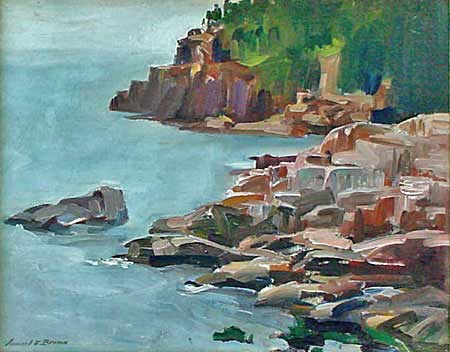
"MONHEGAN SHORELINE"
SAMUEL EMMONS BROWN (1886-1964)
ORIGINAL OIL ON CANVASBOARD 16” X 20”
AMERICAN STYLE ARTS & CRAFTS FRAME 21.5" X 25.5”
$1800
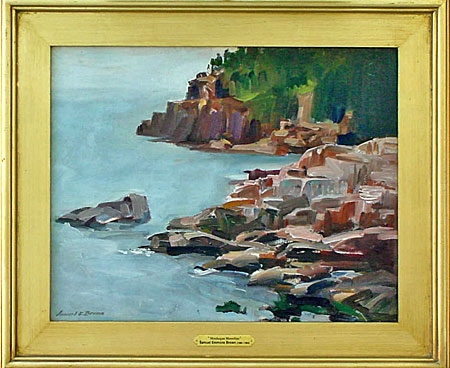
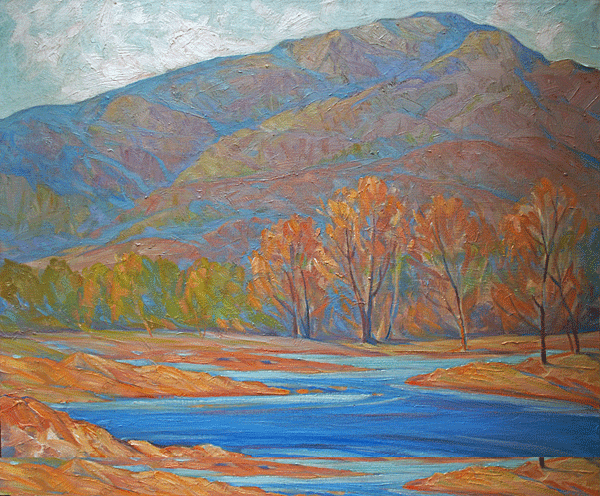
Elwyn George Gowen 1895-1954
Mountain Shadows, 1944
Oil on Canvas 22 x 28
$1400
Elwyn Gowen graduated from the School of The Museum of Fine Arts, Boston in 1918 with highest honors. He was awarded the Ripley Scholarship, the Thayer Prize and two consecutive years of the Cummings Traveling Scholarship in Europe. Further studies were completed at the New York School of Interior Decoration. He served as personal assistant to analytical color and research designer Dr. Denman W. Ross of Harvard University and collaborated with Jay Hanbridge in developing the principals of Dynamic Symmetry.
Mr. Gowen was engaged by the Boston Museum of Fine Arts to measure and analyze the antiques in the Department of Classical Art. When the new wing to the School of the Museum of Fine Arts was completed in the mid-20's Elwyn was appointed to supervise the entire interior decoration. The Degree of Master Craftsman was conferred on him by the Boston Society of Arts & Crafts in recognition of his work in the design of textiles, metal work and other crafts. He Served as a member of the council, jury member, critic, and chairman of the Craftsman Advisory Board. Gowen's work in fabrics and metals were distributed throughout the country and examples of his work could be seen in the restoration of Williamsburg, Virginia.
In 1932 Mr. Gowen participated in outside painting classes with Charles H. Woodbury in Ogunquit, Maine and following the course was invited to serve as an instructor and associate to Mr. Woodbury at the Ogunquit and Boston studios. He also held teaching positions at the School of the Museum of Fine Arts, the Scott Carbee School of Art, The Attleboro Museum of Art, and conducted private classes in Milton and Wellesley, Massachusetts, and also in Portland, Sanford, Ogunquit, Kennebunk, and Kennebunkport, Maine. He concluded his career as Artist in Residence at Nasson College in Springvale, Maine. Elwyn belonged to the Boston Society of Independent Artists and was a "First Member" of The Barn Gallery in Ogunquit, Maine and also exhibited his paintings in Boston, Philadelphia, and New York City.
Elwyn Gowen's training in the late teens and early twenties provided him with a firm foundation in the science of color, and deeply rooted him in design and composition. Under Mr. Woodbury's tutelage his woks came alive with spontaneity. His color palette is so unique that it inspires retina retention and his oil paintings and watercolors become instantly recognizable when viewed. Careful study of his masterful brush strokes reveal a unity of form and color with sweeping rhythmic symmetry. Gowen was most prolific during the 1930's with the majority of his works found in the family attic bearing those dates.
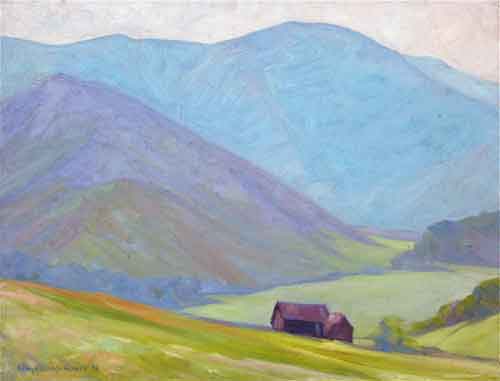
Elwyn George Gowen 1895-1954
Afternoon Haze, 1936
oil on canvas, 20 x 26
$1250
|
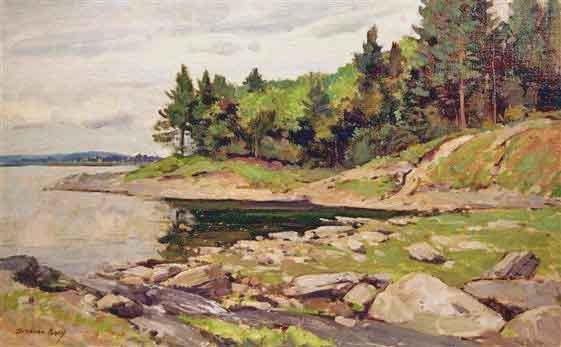
Bernard Corey (1914-2000)
Coastal Inlet
signed Bernard Corey, l.r., oil on board 10 x 16
Ornate Gold Frame 16 x 22
$3400
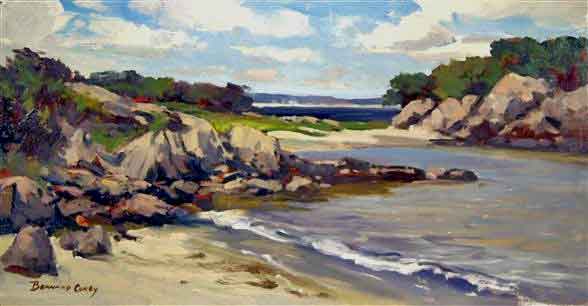
Bernard Corey (1914-2000)
Maine Beach
oil on board 7 1⁄4 x 14
signed Bernard Corey, l.l.
$2800

Bernard Corey (1914-2000)
Maine Surf
signed Bernard Corey, l.l.,
oil on board 12x16
Framed in Silver 18 x 22
$3600
Bernard Corey is one of New England's most beloved landscape painters of the 20th century. He executed paintings surely en plein aire with accuracy and competence. Memberships included the Rockport Art Association, Salmagundi Club, the Guild of Boston Artists, North Shore Art Association and more. Having won over 100 awards and honors, including awards at the North Shore Art Association, Rockport Art Association, Salmagundi Club, NYC, Hudson Valley Art Association, Providence Water Color Club, Allied Artists of America and many more. He painted almost every day of his life with fellow artists in the fields, along the streams and beaches and in the mountains in and around New England. Although the artist traveled throughout the world, Paris made little impression on him. He was American through-and-through.
Bernard Corey was the "last of the old school" of traditional New England landscape painters. When he died early in 2000, the era when artists painted for ten hours a day, every day with competency came to an end. Corey's carefully painted impressionistic plein aire canvases captured the essence of nature in all four seasons. The Rockport Art Association gave Corey a retrospective exhibition (October-November 2000) saluting the artist's profound understanding of nature and painting.
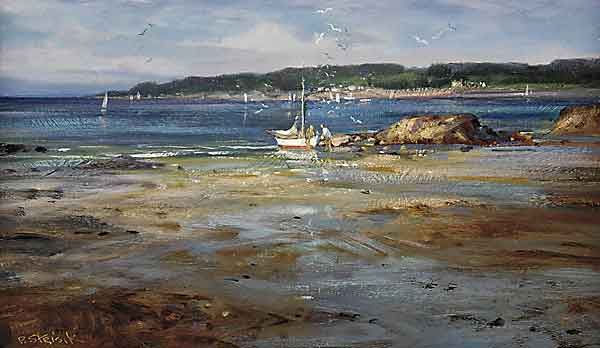
Paul Strisik N.A. (1918-1998)
Summer Sail
Oil 12 x 20, Signed ll
Framed with linen liner, Condition: excellent
$6800
Born in Brooklyn, New York, Paul Strisik became a resident of Rockport, Massachusetts, where he did landscape painting that brought him national recognition. After serving in the Navy during World War II, he studied at the Art Students League in New York City and with Frank Vincent DuMond. In 1953, he moved to Rockport, where he was active in the Art Association and other local civic organizations.
He was a member of the National Academy of Western Art, the American Watercolor Society, and the Oil Painters of America. During his long career, he won 185 awards including 16 gold medals. He and his wife, Nancy, also maintained a home in Santa Fe for 12 years, and in 1996, he was honored as Artist of the Year by the Santa Fe Rotary Club. He was widely respected for his willingness to share his talents with young artists, and taught numerous workshops including at the Scottsdale Artists' School. He wrote several books, his last one being "Capturing the Light in Oils." A reviewer in "Art Talk" quoted him: "God's light on a blade of grass is such a miracle, and so difficult to capture in paint; it is worth a lifetime of trying" (10/98). He died July 22, 1998 at his home in Rockport.
Credit
American Art Review, 10/2001
Judith Curtis, "The Life and Art of Paul Strisik"
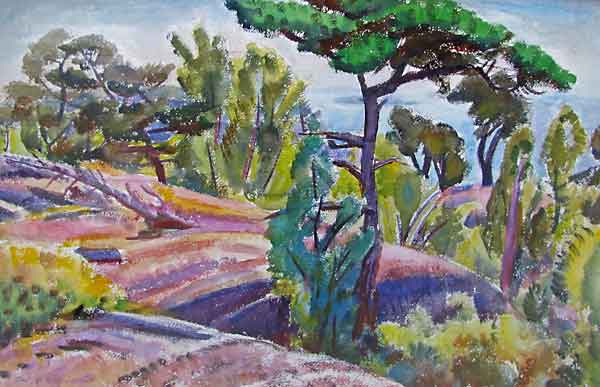
Carl Gordon Cutler (1873-1945)
“Umbrella Pine”
Watercolor on paper, 19.5x 24.5”
Framed 30 x 37
$2400
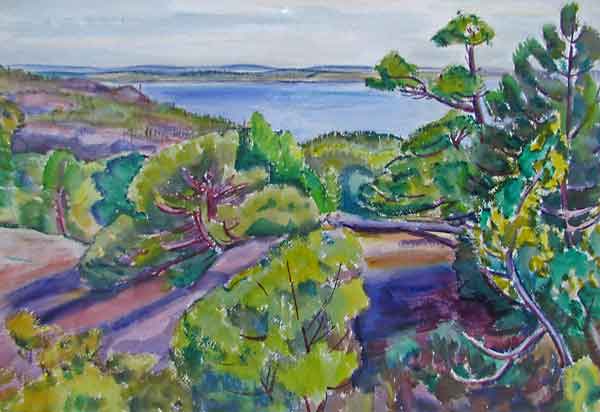
Carl Gordon Cutler (1873-1945)
“View of Eggemoggin Reach”
Watercolor on paper, 17.5x 24.5”
Framed 30 x 37
$2400
Carl Gordon Cutler was born in 1873 in Massachusetts. Though educated in the painting of portraits in oil, his two major artistic passions would become the landscape of Maine and the use of watercolor. His watercolors, influenced by Fauve color and John Marin's forms, were exhibited in Europe and the eastern United States, in Boston; Philadelphia; the Museum of Modern Art, and Whitney Museum of American Art, both in New York City; and, farther west, at the Art Institute of Chicago, Illinois; as well as Paris, France. Cutler had more than a dozen one-man shows in New York City and Boston.
Cutler studied in the late 1890s at the School of the Museum of Fine Arts, Boston, where influence of the old masters on the painting of oil portraits was strong. He also worked at the Academie Julian in Paris. Cutler had some exhibition success there, but it would take several years after his return to America before his mature style would appear. Cutler first painted the Maine coast soon after the Armory Show. By the mid-1920s, he was painting watercolors of the state's landscape exclusivelyviews of Deer Isle, Mount Desert, the Camden Hills and--for thirty summers, Eggemoggin Reach, where Cutler had a cottage. The artist received the plaudits of the critics and acclaim from the public. He spent the last 30 years of his career focusing entirely on painting Maine's Penobscot Bay region.
Carl Cutler was a respected color theorist. In his 1923 book Modern Color, with Stephen C. Pepper, he explained a detailed system involving a scale of 168 colors, telling how to imitate the appearance of natural light through their use. He also discussed emotion as a significant element in artistic creation. In 1994, the Vose Gallery, in Boston, put out a color brochure, Carl Gordon Cutler Along the Maine Coast 1873-1945. Also in the 1990s, the Babcock Gallery, in New York City, published Carl Gordon Cutler, American Modernist Rediscovered, a paperback with forty-four color reproductions and an essay. In 1998, the Portland Museum of Art, in Maine, held an exhibition, "Modern Color": Maine Watercolors by Carl Gordon Cutler, comprised of sixteen out of a total of fifty-nine Cutler watercolors bequeathed a year earlier to the Museum by Mr. and Mrs. James E. Haas. Also in 1998, the College of the Atlantic, Bar Harbor, Maine, exhibited fourteen of Cutler's Maine coastal landscapes painted in the South Brooksville area on the Blue Hill Peninsula.
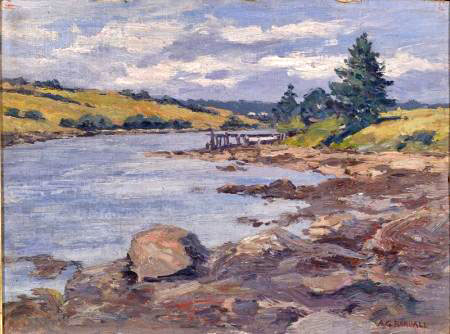
Asa Grant Randall (1869-1948)
"Summer Afternoon at Boothbay"
Oil on canvasboard, 12 x16
$1600
Asa Grant Randall founded the Boothbay Art Colony in Maine in the early 1900's. Randall, from Waterboro, Maine, first visited Boothbay in 1905 and loved the area so much, he was back the following summer, launching what became "The Commonwealth Colony of Art and Industry." Here's how he described the area in a later brochure about his school:
"Boothbay Harbor, the beautiful town by the sea, is the gem of the whole coast. It has been said of this town that nowhere is there a spot with the air more odorous with the scent of the evergreen forest mingled with the clear, bracing salty breath of the ocean. Nowhere can the skies be bluer or the waters clearer. Nowhere is the scenery more beautiful or the surroundings more peaceful."
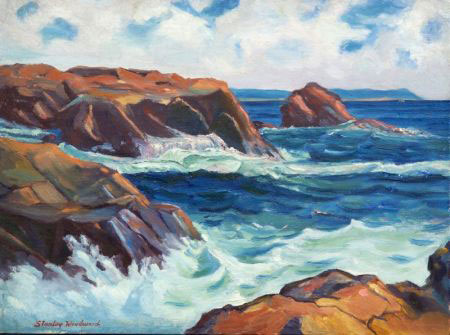
Stanley Wingate Woodward (American, 1890-1970)
When the Wind Blows West
Oil on Canvas 12 X 16 in.
Stanley Wingate Woodward was a Rockport school painter of marine subjects. He was the author of "Adventures in Marine Painting" and "Marine Painting in Oil and Watercolor" He exhibited widely ( the Penn-sylvania Academy, Corcoran Gallery, National Academy, Boston Museum of Fine Arts, etc.) He was awarded many prizes, National Academy, American Watercolor Society, Baltimore Watercolor Society, Rockport Art Association, North Shore AA, etc. His work is in The Boston Museum, Fort Worth, Univ. of Michigan , Bowdoin College, Amherst College, etc.
|
Stop by and visit the gallery anytime during the summer or for the opening reception on Friday, July 16th, 5-7 pm
See the calendar for future exhibitions.
|

|
|

